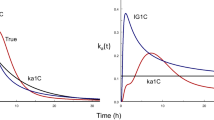Abstract
Purpose. The purposes of this study were to evaluate the use of individual compartmental and population compartmental methods for bioequivalence determination, and to determine their utility as adjuncts to the current methods used for bioequivalence assessment.
Methods. Data from three bioequivalence studies of chlorthalidone were analyzed with PCNONLIN using individual compartmental modeling and NONMEM for population analyses. These results were compared with results obtained from the traditional noncompartmental or SHAM (slopes, heights, areas, and moments) approach for bioequivalence assessment and the 90% confidence interval procedure.
Results. Individual compartmental modeling and population compartmental modeling techniques performed well on this routine set of bioequivalence data which displayed simple pharmacokinetic properties. A direct assessment of the analysis methods was made by comparing the final estimates and 90% confidence intervals for the test to reference ratios (T/R) of AUC and CMAX. The final estimates and 90% confidence intervals for AUC T/R and CMAX T/R were similar and suggest consistency of results, independent of the method used.
Conclusions. These results demonstrate the utility of modeling techniques as adjuncts to the traditional noncompartmental approach for bioequivalence determination.
Similar content being viewed by others
REFERENCES
W. J. Jusko. Guidelines for Collections and Analysis of Pharmacokinetic Data in Applied Pharmacokinetics: Principles of Therapeutic Drug Monitoring, Applied Therapeutics, Inc., 1992, p. 2-1–2-43.
H. L. J. Fleuren, T. A. Thien, C. P. W. Verwey-van Wissen, and J. M. van Rossum. Absolute bioavailability of chlorthalidone in man: a cross-over study after intravenous and oral administration. Eur. J. Clin. Pharmacol. 15:35–50 (1979).
R. N. Patnaik, M. L. Chen, S. V. Dighe, and R. L. Williams. Guidance on statistical procedures for bioequivalence studies using a standard two-treatment crossover design. Division of Bioequivalence, Office of Generic Drugs, Food and Drug Administration, 1992.
The GLM procedure. SAS Institute Inc. SAS/STAT User's Guide, ed. 6.03. Cary, NC: SAS Institute Inc., 1988:549–640.
C. M. Metzler and D. L. Weiner. PCNONLIN Users Guide, 3rd ed. Lexington, KY: Statistical Consultants, Inc., 1989.
A. J. Boeckmann, L. B. Sheiner, and S. L. Beal. NONMEM User's Guide—Part V. San Francisco, CA: Univ of California Regents, 1992.
L.B. Sheiner, B. Rosenberg, and V. V. Marathe. Estimation of population characteristics of pharmacokinetic parameters from routine clinical data. J. Pharmacokin. Biopharm. 5:445–479 (1977).
L. B. Sheiner and S. L. Beal. A note on confidence intervals with extended least squares parameter estimates. J. Pharmacokin. Biopharm. 15:93–98 (1987).
rnorm Function, S-Plus Reference Manual, Statistical Sciences Inc., 1991.
D. J. Schuirmann. A comparison of the two one-sided tests procedure and the power approach for assessing the equivalence of average bioavailability. J. Pharmacokin. Biopharm. 15:657–680 (1987).
N. Kaniwa, N. Aoyagi, H. Ogata, and M. Ishi. Application of the NONMEM method to evaluation of the bioavailability of drug products. J. Pharm. Sci. 79:1116–1120 (1990).
D. A. Graves and I. Chang. Application of NONMEM to routine bioavailability data. J. Pharmacokin. Biopharm. 2:145–160 (1990).
M. O. Karlsson and L. B. Sheiner. Estimating bioavailability when clearance varies with time. Clin. Pharmacol. Ther. 55:623–637 (1994).
L. B. Sheiner. Bioequivalence revisited. Stat. Med. 11:1777–1788 (1992).
Author information
Authors and Affiliations
Rights and permissions
About this article
Cite this article
Pentikis, H.S., Henderson, J.D., Tran, N.L. et al. Bioequivalence: Individual and Population Compartmental Modeling Compared to the Noncompartmental Approach. Pharm Res 13, 1116–1121 (1996). https://doi.org/10.1023/A:1016083429903
Issue Date:
DOI: https://doi.org/10.1023/A:1016083429903




